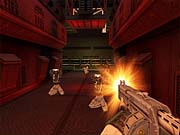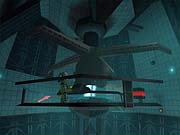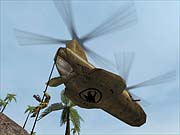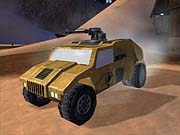Command & Conquer Renegade Updated Preview
We revisit the Westwood offices for an updated look at this upcoming first-person shooter.

A few weeks ago, we ventured out into the Las Vegas desert to visit the Westwood headquarters to take a look at the upcoming Command & Conquer Renegade, the much anticipated and equally delayed 3D action shooter. When Renegade was first shown to us early last year, we assumed that the game would have hit store shelves by now. But as the game is a first for Westwood--first 3D game, first action game--the delays can be forgiven. Thankfully, with these delays come changes and improvements to the game, and the Renegade we saw a few weeks ago looked markedly different from the Renegade we saw last year. The biggest change is undoubtedly the shift in your perspective from a third-person view to a much more user-friendly first-person camera angle. Yes, Command & Conquer Renegade is now a true first-person shooter and will likely compete with the likes of Medal of Honor: Allied Assault, Red Faction, Duke Nukem Forever, and Return to Castle Wolfenstein, all of which are due out later this year. According to Westwood, this change was brought about largely because of the need to make Renegade play more like an action game--first-person action games simply offer a level of control that third-person games seem to have a hard time mimicking, particularly when ranged combat and depth perception play as integral a role as they do in Renegade.

Renegade is now quite playable--a notable change from the state it was in when we last visited Westwood. In fact, to demonstrate this point, we were able to play through the third mission of the game's single-player campaign, which takes place on a NOD island in the middle of a GDI invasion. Your character, Nick "Havoc" Parker (the same commando unit from the original Command & Conquer), is dropped by parachute into the water about 50 yards off the beach. From this vantage point, you're given an excellent view of the invasion as it happens: NOD SAMs on the beach fire at incoming GDI transport helicopters and Orcas, while GDI ships hammer the NOD emplacements with a hail of gunfire. We then dispatched the handful of NOD soldiers foolish enough not to seek cover by using Havoc's trusty sniper rifle shortly before storming the beach with a group of other GDI soldiers. Interestingly enough, you can walk up to any of the GDI infantry in the game and "activate" them to follow you around. While you won't be able to give them direct orders to attack a specific target or cover your flank, these allies are competent enough to prioritize their attacks and provide cover fire on their own.
After a few minutes of playing this mission, some interesting technological aspects of Renegade become apparent. The first is the game's location-specific reaction system. Character models in Renegade have between 12 and 16 "hit zones" that determine how they will react when they're shot. For instance, a shot in the shoulder will throw an enemy backward, while a gut shot will cause him or her to double over. The second is a level design technique that lets the developer give any object in the game multiple states of existence. That is, a wall can be laid out in a manner that lets you interact with it by either shooting out a small chunk of it or destroying the wall altogether. This means that Renegade will have a number of secret areas for you to explore that will only be accessible by demolishing your surroundings. Aesthetically, this also means that structures will show off various states of damage using more than simple texture swaps.

We were also given the opportunity to play the game's fifth mission, located in a mountain village of an Eastern European country. It's during this mission's briefing that more of Nick Parker's past is revealed. Havoc was originally part of a group of elite operatives called the Dead Six--"Dead" because, officially, all its members perished in combat. For reasons unknown, Havoc left the Dead Six a few years prior, as did another operative known only as Sakura. Unlike Havoc, however, Sakura opted to join the Brotherhood of NOD instead of the GDI, and as Nick Parker, you'll run into your old "friend" on numerous occasions throughout Renegade's campaign. (At the end of the third mission, she attacks you using a Comanche chopper.) This mission requires you to rescue another ex-Dead Six member called Deadeye, who's pinned down by enemy fire near the edge of the town. Trekking through this level is particularly treacherous, since the numerous rooftops and windows provide enemies with a great vantage point from which to snipe at you. Playing through this mission, we noted another cool aspect of Renegade's technology: enemy respawns. Like in most games, the levels in Renegade have an infinite number of enemies--once you kill a NOD soldier, it'll only be a matter of time before someone else replaces him. When these replacements spawn into the level, they do so in a manner that's designed to maintain your suspension of disbelief. For example, most enemies will be dropped into the world by a constant stream of troop helicopters, while others can be seen running out of structures and houses. You'll never see a soldier spawn into a level out of thin air.

These enemy soldiers are split off into specific classes and ranks. In Renegade, there are four ranks for both the GDI and NOD infantry. They are enlisted men, officers, special forces, and bosses. Additionally, each of these ranks is split up into six unique classes: minigunner, rocket soldier, grenadier, engineer, flamethrower, and mutant. Obviously, the higher in rank the soldier, the more combat skill he or she will possess. For instance a rocket soldier officer not only has better hearing than an enlisted rocket soldier, but he can yell out louder. What's the implication of these seemingly harmless characteristics? An officer will be able to detect your footsteps from quite a distance, and he can also alert others by raising his voice more effectively than an enlisted trooper can.
Graphically, Renegade should be on par with the latest batch of action games. Westwood is developing the game to take advantage of a number of DirectX 8 features, and each level will have various, and sometimes dynamic, environmental effects like darkening skies when storms approach and weather effects for snow, rain, lightning, and even ash from firestorms. Renegade will have a total of 11 single-player missions and a number of ambitious multiplayer modes. In fact, in addition to the first level of the game, Westwood hopes to shine the spotlight on Renegade's multiplayer component at this year's E3 in Los Angeles. And while 11 levels might not sound like a lot, Westwood assures us that some of the levels will take hours to complete the first time around. The game also separates itself from other first-person shooters in that it gives you the ability to control a wide variety of Command & Conquer vehicles, like the dune buggy, harvester, and stealth tank. Unfortunately, the appealing feature of being able to fly an Orca has been removed from Renegade because of some culling issues that the design team encountered. According to Westwood, it would take another six months of development to incorporate that feature. Regardless, Renegade should prove to be a strong alternative to the upcoming crop of action games.
Got a news tip or want to contact us directly? Email news@gamespot.com
Join the conversation